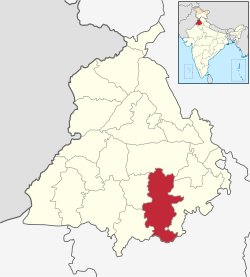Horticulture crops occupy a relatively low proportion of gross cropped area in the district, diminishing the economic viability of solar pumps here. Overall, the water availability for irrigation in the district (based on ground water development and long-term trends of water level decline) is critical since the resource is overexploited, jeopardizing the long-term sustainability of solar pumps. The average monthly per capita expenditure of rural agricultural households is relatively high for the district, suggesting higher purchasing capacity of the farmers here. For average crop revenue per holding, the district appears among the top 25 percentile of districts, implying higher investment capacity of the farmers here. The district has a relatively high penetration of banks in rural and semi-rural areas, facilitating higher access to institutional credit for farmers. The number of medium and long-term institutional loans disbursed in the district is comparatively large, suggesting the availability of credit amongst farmers for potential investments. It has a relatively low proportion of small and marginal farmers.
Deployment Approaches
| Approaches | Feasibility |
|---|---|
| Individually owned off-grid solar pumps | Limited Suitability |
| Solarisation of feeders | Limited Suitability |
| Solar based water as a service | Not Suitable |
| Promote 1 HP and sub-HP pumps | Not Suitable |
| Solarisation of individual grid-connected pumps | Not suitable |
Individually owned off-grid solar pumps
Limited Suitability
The district has a relatively high disbursement of institutional credit and high crop revenue per holding. However, ground water availability is below the safe limit, and concentration of diesel pump users is comparatively low, making it very difficult to promote the private ownership of solar pumps here.
| Parameter | Value | Percentile |
|---|---|---|
| Number of cultivators reporting use of diesel pumps | 4,991 | 32 |
| Water Availability Index | 0.1 | 7 |
| Crop revenue per holding (INR) | 519,839 | 96 |
| Medium and long term institutional credit disbursed in a year (in INR Crore) | 301.7 | 87 |
Solarisation of feeders
Limited Suitability
The district has a relatively high penetration of electric pumps and a comparatively high extent of feeder segregation but its DISCOM incurs a relatively low cost for supplying power. As the power purchase rate of the DISCOM increases going forward, solarisation of the feeders may become economically viable in the district.
| Parameter | Value | Percentile |
|---|---|---|
| Actual cost of power supply (INR/kWh) | 5.94 | 41 |
| Extent of feeder segregation | 95% | 65 |
| Proportion of cultivators reporting use of electric pumps | 86% | 99 |
Solar based water as a service
Not Suitable
The district has a rather low concentration of small and marginal farmers and a relatively low proportion of unirrigated area. Moreover, groundwater availability is below the safe limit, making it extremely difficult to promote solar-based irrigation through the water-as-a-service model here.
| Parameter | Value | Percentile |
|---|---|---|
| Water Availability Index | 0.1 | 7 |
| Proportion of small and marginal cultivators | 35% | 7 |
| Unirrigated net sown area as a share of total net sown area | 0% | 0 |
Promote 1 HP and sub-HP pumps
Not Suitable
Groundwater availability in the district is below the safe limit, the concentration of marginal farmers is rather low, disbursement of institutional credit to marginal farmers is also comparatively low, and the proportion of horticulture crops under gross cropped area is relatively low, making it extremely difficult to promote 1 HP and sub-HP pumps here.
| Parameter | Value | Percentile |
|---|---|---|
| Area under horticulture crops as a share of gross cropped area | 1% | 12 |
| Water Availability Index | 0.1 | 7 |
| Proportion of marginal cultivators | 16% | 9 |
| Medium and long term institutional credit disbursed in a year (in INR Crore) | 301.7 | 87 |
Solarisation of individual grid-connected pumps
Not suitable
The district has a relatively high penetration of electric pumps, ground water available within the safe limits and a comparatively high extent of feeder segregation but agriculture power subsidy is not very significant. Further with the groundwater availability below the safe limits, solarisation of individual grid-connected pumps may not be the right approach for the district
| Parameter | Value | Percentile |
|---|---|---|
| Water Availability Index | 0.1 | 7 |
| Actual cost of power supply (INR/kWh) | 5.94 | 41 |
| Extent of feeder segregation | 95% | 65 |
Leveraging Solar Pumps to Promote Policy Objectives
If you are deploying solar pumps in this district then you can further these policy objectives.
Doubling Farmers’ Income – Crop Diversification
In the district, horticulture crops occupy a relatively low proportion of gross cropped area, indicating an opportunity for growing more high value non-staple crops. Solar-powered irrigation could be an alternative source of reliable irrigation, making it easier to achieve crop diversification and enhance farmers’ incomes.
| Parameter | Value | Percentile |
|---|---|---|
| Area under horticulture crops as a share of gross cropped area | 1% | 12 |
National Mission on Oilseeds and Oil Palm (NMOOP)
The relatively low share of oilseeds and oil palm crops under gross sown area in the district makes it a suitable candidate for promoting NMOOP. Solar pumps could meet irrigation needs for these crops and help farmers diversify their yields beyond cereals.
| Parameter | Value | Percentile |
|---|---|---|
| Area under oilseeds as a share of total cropped area | 7 |


